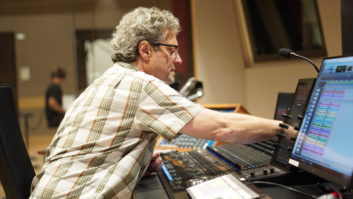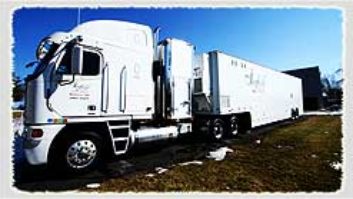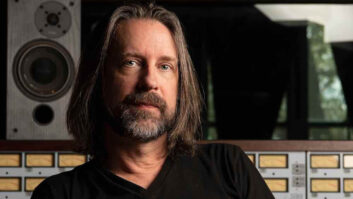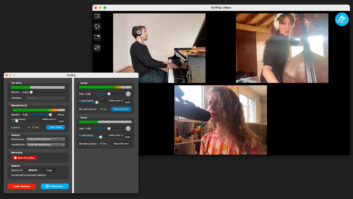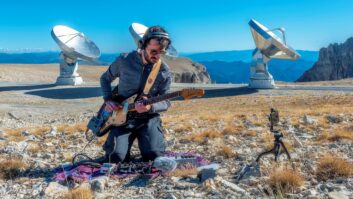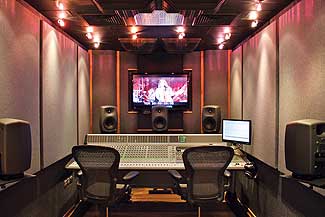
The remote recording business is dying. The remote recording business is booming. It’s about music. It’s about broadcast. Ask 10 remote recording engineers about the state of their world, and you’ll get 10 different answers. A historically small market, the remote world is certainly shrinking, with fewer players competing for smaller budgets and fewer projects. But given the challenging financial climate, most of the major companies are at the least cautiously optimistic, and at best enthusiastic, about brighter days ahead. And all are finding innovative ways to streamline and reinvent themselves.
Trickle-Down Trends
Music Mix Mobile’s East Coast truck is pictured on the front cover. This interior photo shows the company’s new West Coast truck, which will act as the remix facility for the 2010 Grammy Awards. Both Music Mix Mobile facilities are equipped with full-blown Pro Tools recorders/D-Control surfaces, Genelec 8200 Series DSP surround monitoring and more than 112 channels of Grace Design preamps.
Many changes in the remote business are indicative of larger shifts in music-industry models. Album sales are no longer success indicators; new releases support tours, which support 360-degree merch deals. Concert-recording budgets have dwindled, and clients either choose to record shows themselves with low-cost rigs or forego live-recording projects entirely — with remote trucks left feeling the pinch.
Karen Brinton, president of Remote Recording, which handles high-profile projects such as the HD broadcasts of the Metropolitan Opera and the Academy Awards, says the past year has been challenging. “Budgets just keep getting smaller and people keep wanting more for less, so I’ve been trying to find ways to still deliver quality to clients on a smaller budget. It’s not easy.”

Kooster McAllister at the Yamaha DM2000
Kooster McAllister, who has been operating the Record Plant Remote truck for more than three decades, has also seen difficult times. “Counting inflation and everything, the truck is going out for less of a daily rate than it did 10 years ago. And the attitude is, take it or leave it,” he says. “I’ve been doing this long enough where I’m still one of the go-to people who gets the calls. And I would rather have some money than no money. But it’s a slippery slope to get onto.”
Bucking the downward trend somewhat is Music Mix Mobile, which in its first 18 months of business has expanded operations to the West Coast, and worked on projects ranging from VH1’s Storytellers with the Foo Fighters to the Country Music Awards and this year’s Grammys. Partner and technical engineer Joel Singer attributes the company’s success to its “dream team” of veteran mixers: “Two of my partners are the most demanded live music broadcast engineers in the business — John Harris and Jay Vicari — and I’ve just built good technical facilities for them.” Singer says the trucks were designed for new workflow rather than the most cutting-edge gear. “It’s basically built around workflow to a way where we could streamline projects that didn’t require having 30 percent more budget to do them. When you get that call, and they say, ‘After you record this, we also want you to mix it,’ it becomes more of a project than what a lot of our competition is doing by just going out and recording”
From Music to Broadcast
While some remote trucks continue to find solid work in music recording, in general most of the projects with the budgets are in broadcast. “Our business has definitely shifted,” says Brinton. “The only way to adapt and stay in business is to realize we’re making TV now.”
Guillaume Bengle, president of Le Studio Mobile (Montreal), which recently celebrated its 30th anniversary with the launch of a new truck, says most of his traditional projects (music and radio) have been replaced by TV and satellite radio work — and TV trends drive the business. “If television still produces big audio music shows trucks will survive,” he says. “In Canada, comedy shows are fashionable — and, of course, they don’t need us; it’s usually one guy with a mic. As long as music stays an important factor in television, they’ll still need us.” Bengle, who’s been covering Canada’s Juno Awards for 23 years, says big award shows are important, as are “things like HDNet, which has a lot of live music shows.”
Many remote facilities are banking on high-definition broadcast media to boost business. “We do the HD broadcast of the Metropolitan Opera into theaters around the country, which has been really successful,” says Brinton. “So I’m hoping that the quality of that is contagious and there are more things done that way.”
“With 5.1, people expect better audio and producers know that,” adds Bengle. “The generalization of 5.1 has helped us because smaller studios can’t do that well, and TV trucks can’t because they are made for sports.”
Sometimes the “product” is there, but monetizing it is a challenge. “I just did a show in Nashville called All for the Hall, which was a benefit for the Country Music Hall of Fame,” says McAllister, “and it was like a who’s who in the entertainment industry: Keith Urban, Vince Gill, Brad Paisley.” Yet no television networks wanted to pick up the show. “It ended up going out over the Internet. And the way they’re making their money on that is, they called me up the next day to remix a Faith Hill song that they were putting out as a ringtone. That’s what we’ve been reduced to — ringtones on cell phones. It’s not that there’s nothing that needs to be recorded; it’s because companies don’t have a profitable venue to sell these new products.”
The Internet still provides unparalleled promotional opportunities, but low-revenue potential — at least for now Bengle sees “live to Internet” as a viable prospect for the future. “We did a couple of shows that were broadcast over the Internet, but it has not yet materialized,” he says. “I think it will take a certain number of years because just doing a music show involves lots of money, and for TV they can go there with small cameras and it’s much simpler than it was. You may not need the big TV rigs for Internet shows, but audio is still complicated for them and that’s good for us.”
D.I.Y. at FOH
The fact that artists can record their own shows accounts for a large drop in midlevel remote recording gigs. “The advent of those front-of-house systems eliminated much of the middle of the market, leaving only the high end, where the artist and producer are concerned about reliability, quality and a proper acoustic environment,” laments David Hewitt, who recently left the remote truck world after nearly 40 years and launched his own company, Hewitt Remote Services, to consult and facilitate projects nationwide. “You pay for quality up front or you can pay for trying to fix it in post.”
Singer says he realized years ago that the concert DVD business would change drastically as it got easier and cheaper for clients to bring their own recording rigs on tour. “Now the smarter ones still said, ‘When I’m going to bring in a 20-camera shoot, even though we’re recording every night, I’m going to bring in a remote facility because it’s money well spent to make sure the thing goes down without a hitch,’” he says. “But no one’s getting middle-budget stuff, like bands who wanted to do a DVD. They’d rent a video flight pack and have their front-of-house engineers record on a [Digidesign] VENUE. But we had already moved away from that, and we’re entrenched in doing broadcast music television.”
“That’s why we left the CD market; it’s gone,” says Bengle, “because people will come and put a computer next to the console and they’ll have audio. They’ll work more in post-production of course, but they’re okay with that. In TV, they can’t do that yet. Not with the same kind of flexibility and safety that big trucks provide.”
Bengle adds that production-wise, stakes can be higher for broadcast projects. “If you do a CD and it doesn’t work one night, you say, ‘Oh, we’ll come back the night after.’ In TV, they can’t do that; not with the price of the big TV trucks. So what we have to offer is reliability and redundancy, which a PC next to the console doesn’t provide.”
Yet for many mid-level acts, recording their own gigs is sometimes the only option within their budget, and accommodating them is a revenue stream. “A lot of times, clients don’t have a budget to bring a recording truck out and do a show,” says Scott Peets, director of remote recording at Los Angeles-based Design FX, which also operates a large equipment-rental business. “But we can put together a Pro Tools flight pack that includes 48 channels of preamps and a Pro Tools rig with a monitoring system that they can take with them. So a lot of times, when bands might not be able to afford to record the show, they can get these smaller rigs and can capture not only one show, but they can use it on maybe 10 shows.”
McAllister has a rudimentary flight pack, and sees some business moving in that direction. “But then it comes down to, do I want to be a rental company or do I want to be a recording engineer?” Bengle also gets requests for flight packs, but prefers to work himself, in his truck. “That’s the way I work. Some people do [flight packs] very well and have everything ready to go; I don’t want to do that. I think there’s a right way to do things in a truck, and my truck can go almost anywhere.” Bengle notes that clients will often try recording themselves with a flight pack but end up returning for full services. “They realize that the flight pack — with the additional work that it involves — can cost them almost as much as my services.”
The Value of Experience
In the remote world, just like in the studio world, mere access to equipment simply isn’t enough; talent and expertise matter most. “Generally speaking, people who hire us aren’t interested in the gear; they hire us for us,” says Dan Childers, an engineer at Austin’s MediaTech, who has worked many Austin City Limits festivals and engineered live recordings for the likes of the Allman Brothers, the Black Crowes and Buddy Guy. “It may be that we’ve lost some work to some cheaper flight-pack guys, but people know what we do, and we do a good job: Everything’s organized, everything runs smooth from their perspective. And that’s what we sell; we don’t really sell cheap prices.”
Adds Singer: “Equipment doesn’t make you a remote facility — people make you a remote facility. You could put a $600 console in front of my guys, and it would be totally different than putting $1 million console in front of another guy,” Singer continues. “It’s that old Eddie Van Halen thing: Just because you pick up Eddie’s guitar doesn’t mean you play like Van Halen. He can pick up your guitar and still be Van Halen.”
And like studio projects, remote productions are collaborative efforts. “There’s a saying on the road that ‘the show is that little inconvenience between the load-in and the load-out,” says Hewitt. “There is so much more to a successful live recording than just showing up and moving faders. The pre-production and logistics can be very daunting: Communicating and interfacing with sound reinforcement, touring production, video production and venue production are all vital. In this era of staff and budget cuts, this work is often left undone and the whole production suffers for it.”
Beyond Capture
Remote facilities are re-evaluating their role in the production model, and adapting workflow to smaller budgets at every level, from operating additional trucks in different regions down to sending one fewer tech to a local gig.
“The M3 truck was built for large-scale teleproductions but with high-quality audio in mind,” says Singer. “We’ve adapted with smaller systems and flight pack systems, and things that are more cost-effective for straight capture where [clients] know that they need to save money on the front end so that they can spend more on mixing.” Singer says that’s where workflow comes in. “I’ll give you an example: Jay and John were doing the Rock Hall concerts at Madison Square Garden and we needed to record the Foo Fighters at Sony Studios in L.A., so we took our M3 West truck there. I captured it for Jay, and I used the Jay plug-ins and the Jay method of doing things, and dialed it up for the live cut that night, brought it back to Jay and it was 70 percent done. Jay edited it, and it saved a day-and-a-half or two days of what might have been the final mixing, which saved on the budget for them.”
Analog Sound, Digital Functionality
The Design FX truck, which generally handles music gigs, gets regular calls for its vintage API console. “Broadcast has kind of turned into a whole other field of remote recording, especially when it comes to shows like the Grammys, Billboard Music Awards, these multiband shows,” says Peets. “With digital consoles, you can set them up, do your soundcheck and store them, so when you’ve got 13 bands in a show, you’re not dialing up your EQs and preamps manually — just hit a button and recall. That’s the advantage of a digital console, whereas having an API, it’s more of a sonic quality that you’re going for.”
At Remote Recording, the original “Silver” Neve-based truck is called into service as often as its newer “Polar Express” truck, which is based around Yamaha DM2000s. “I still have a good share of clients who want analog front end,” says Brinton. “For something that’s a one-artist show, I think that’s very appropriate. We still record to Pro Tools or Nuendo or whatever their format of choice is, but they like having it go in analog.”
McAllister, who expanded business with a compact all-digital truck in 2007, had the opposite experience. “My API truck went out four times last year,” he says. “My thought was I would [use] my classic analog truck for people where quality really mattered. The bottom line is, that doesn’t really matter these days. My digital [DM2000-based] truck is the truck that’s working all of the time now. Especially for multiple acts, you need the recall capability.”

Dan Childers of MediaTech works for music clients
including the annual Austin City Limits festival.
Childers says he’s pushing the limits of MediaTech’s Dallas Sound Lab remote truck. “It’s got an old Soundcraft board that sounds great, but it’s a little bit long in the tooth; it can’t really keep up with the technological demands,” he says. “People want instant recallability, super-fast turnover from one band to another.” Childers adds that speed of delivery is a challenge. “Like with Hank Neuberger’s Third Wave Productions, where an audience can go see a festival, see a band, and maybe by the time they get home download the show.”
Bengle capitalized on compact technology in his new truck. “I record 192 tracks now, and that technology takes up maybe a fourth of the space of my old Studer 24-track,” he says. “It’s more flexible, and the truck is a better environment to work in because of the smaller equipment.” He says that he can now arrive at a gig and be ready in an hour or two. “That’s a big difference for producers.”
Other than size and power, Bengle cites redundancy as a crucial technology consideration today. “Things have changed a lot since six or seven years ago when we had those snakes; with 32- or 50-pair snakes, it was difficult to lose that in one single instance,” he says. “With fiber optics, that is possible, so everything must be so much more reliable. That’s why we double most systems. And the safety of the whole thing is something those [smaller] rigs cannot do. If you lose your reference from the video truck — your black reference — and don’t have the proper equipment, you will lose everything — your preamps, your consoles and your recorders, so that’s something I’ve addressed. All the details — word clock, handling of the word clock, distribution — have to be perfect, because if you lose one signal now, you can lose it all.”
Reinventing Yourself
To survive in today’s market, remote companies are diversifying, offering more services and targeting new niches. “The show I just did for David Archuleta — Billboard Live’s series of Internet-based shows — I did it on the Denali silver truck in their audio booth on the video truck because they didn’t have the budget to use my truck for this,” says McAllister. “So I’m sort of reinventing myself, doing things like working on TV trucks, and I’m the music mixer for the Wendy Williams show when she has live acts, and things like that.”
Design FX has the unique benefit of tapping into its extensive rental collection to tailor recording rigs to project needs. “If a client wants to do a record, we have an API console in the truck, as well as Pro Tools and classic gear, but we also have a whole rental inventory — Neve preamps, Avalon preamps, tube microphones — so it’s easy for us to customize the truck to the session,” says Peets. “And if something breaks — let’s say you have a 192 interface go down on your Pro Tools — we can just call the shop and they can just drop one by.”
Going beyond technology, Remote Recording formed a strategic partnership with Joe D’Ambrosio Management, a firm that represents engineers and producers. “It gives me the ability to give my clients more choices as far as engineers; they’re comfortable there’s somebody appropriate for their projects,” says Brinton, who adds that she is constantly looking to expand services. “We are offering more services — post-production, project coordination — whatever we can do to fill in any gaps or any needs. It’s not just about showing up, recording the show and driving away anymore.”
The new year brings new opportunity, and despite the downward trend in the remote business, even the hardest hit are cautiously optimistic. “Through all this, I’m sort of optimistic that things are going to be all right,” says McAllister. “But because of the lull of ’09, prices will never be back up to where they were.”
Many see the industry as just expanding and cycling. “Music’s always going to be around; you just have to adapt to the change,” says Peets. “With the advent of broadband Internet, there’s hope for more demand of high-quality audio for videos from bands.”

Pictured (L-R) are Music Mix Mobile partners Bob Wartinbee, John Harris, Jay Vicari, Mark Linett and Joel Singer. Not pictured: partner Mitch Maketansky
“I love what I do,” says McAllister. “It’s still creative, and I still have people at the end of the day telling me, ‘Great work.’ What I’m more concerned about is my son, who I was thinking I was going to be leaving this great business to. I might have a business, but there might be no business to work in.”
Sarah Jones is the associate director of Women’s Audio Mission, a San Francisco-based nonprofit dedicated to the advancement of women in the recording arts.
